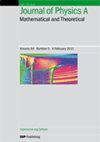疾病传播的被动场和主动场理论
IF 2.1
3区 物理与天体物理
Q2 PHYSICS, MATHEMATICAL
Journal of Physics A: Mathematical and Theoretical
Pub Date : 2024-07-21
DOI:10.1088/1751-8121/ad4c31
引用次数: 0
摘要
COVID-19 大流行病在全球范围内的流行使人们对数学模型的开发兴趣大增,这些数学模型可用于描述诸如社会疏远措施、疫苗开发和突变等效应。其中一些模型基于软物质理论的概念。反向研究则相对较少,即流行病学研究的结果如何对胶体和聚合物物理学产生兴趣。在这项工作中,我们考虑了易感-感染-恢复(SIR)-动态密度泛函理论(DDFT)模型,这是流行病学中的 SIR 模型与非平衡软物质物理学中的 DDFT 的结合,它允许对社会距离进行明确建模。我们从流行病学的角度扩展了 SIR-DDFT 模型,将疫苗、无症状、再感染和突变等因素纳入其中;从软物质的角度扩展了 SIR-DDFT 模型,将噪声和自推动力纳入其中,并推导出一个相场晶体 (PFC) 模型,以简化描述。在此基础上,我们通过计算机模拟研究了流行病学模型如何受到非互惠相互作用的影响。这是在僵尸爆发的数值研究中实现的。本文章由计算机程序翻译,如有差异,请以英文原文为准。
Passive and active field theories for disease spreading
The worldwide COVID-19 pandemic has led to a significant growth of interest in the development of mathematical models that allow to describe effects such as social distancing measures, the development of vaccines, and mutations. Several of these models are based on concepts from soft matter theory. Considerably less well investigated is the reverse direction, i.e. how results from epidemiological research can be of interest for the physics of colloids and polymers. In this work, we consider the susceptible-infected-recovered (SIR)-dynamical density functional theory (DDFT) model, a combination of the SIR model from epidemiology with DDFT from nonequilibrium soft matter physics, which allows for an explicit modeling of social distancing. We extend the SIR-DDFT model both from an epidemiological perspective by incorporating vaccines, asymptomaticity, reinfections, and mutations, and from a soft matter perspective by incorporating noise and self-propulsion and by deriving a phase field crystal (PFC) model that allows for a simplified description. On this basis, we investigate via computer simulations how epidemiological models are affected by the presence of non-reciprocal interactions. This is done in a numerical study of a zombie outbreak.
求助全文
通过发布文献求助,成功后即可免费获取论文全文。
去求助
来源期刊
CiteScore
4.10
自引率
14.30%
发文量
542
审稿时长
1.9 months
期刊介绍:
Publishing 50 issues a year, Journal of Physics A: Mathematical and Theoretical is a major journal of theoretical physics reporting research on the mathematical structures that describe fundamental processes of the physical world and on the analytical, computational and numerical methods for exploring these structures.

 求助内容:
求助内容: 应助结果提醒方式:
应助结果提醒方式:


